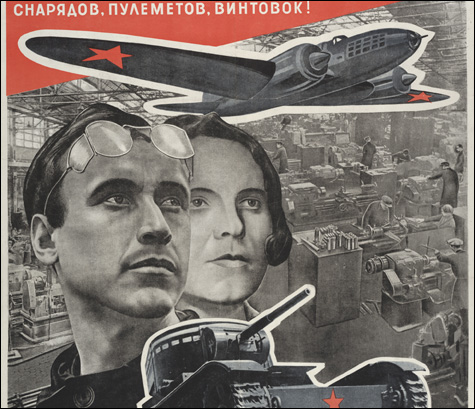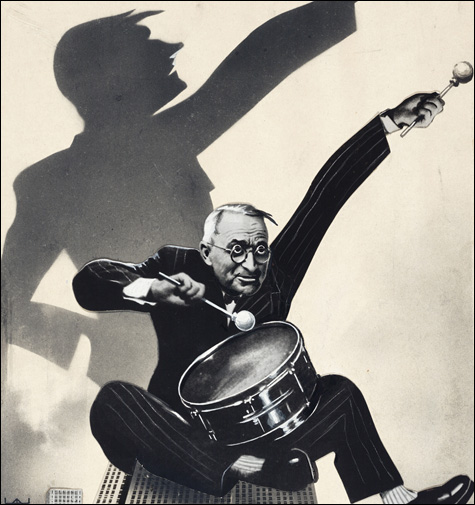
RALLYING CRY: Lissitzky’s “Everything for the Front! Everything for victory!” |
“View And Re-Views: Soviet Political Posters And Cartoons” | Brown University’s David Winton Bell Gallery, 64 College St, Providence + The John Hay Library, 20 Prospect St, Through October 19 |
“Views and Re-Views: Soviet Political Posters and Cartoons” is one of the best exhibits you’ll see in New England this year.
The 160 posters offer a mirror-view of the 20th century. They prompt questions about war and peace, about economics and society that feel rivetingly urgent at a moment when oil dollars are fueling a resurgent Russia, when our debt-fueled consumerism is tanking, when Cold War stories (see Vietnam) are still dominating our politics, and when Russia’s invasion of Georgia last month is inspiring neo-Cold War posturing.
And they simply look cool.
The design — sometimes dubbed Socialist Realism — often crisply mixes photography, illustration, bold typography, and dynamic diagonals, all in signature Soviet red and black. You can sense the style’s roots in the abstractions of Russian Constructivism and German Dada and Bauhaus (though images of Joseph Stalin as big daddy in military garb feel schmaltzy — and creepy). And things can get cluttered with all those masses packed in.
Bell Gallery director Jo-Ann Conklin and history professor emeritus Abbot Gleason, who assembled the show from a private European collection, begin with posters from the 1920s and ’30s promoting communist industrialization and coal production. The heroes are Lenin, Marx, Stalin, and idealized anonymous working men and women of the world. Villains are capitalist pigs. Soviet authoritarian thuggery is conveniently absent.
World War II shifted things for a bit. Red Army soldiers were recruited with images of Nazi bayonets menacing Russian mothers and children. Heroic laborers are now called — as in a 1942 El Lissitsky lithograph — to “Give us more tanks, anti-tank weapons, guns, small arms, artillery, mines bombs, machine guns, rifles! Everything for victory!”

ENEMIES OF PEACE? Zhitomirsky’s Hysterical War Drummer. |
Acid cartoons show Nazis saluting as blood drips down their arms, and caricature Adolf Hitler as an ape with a pistol and axe tracking footprints across Europe. Western powers become Soviet pals in a 1945 poster showing four hands (colored with the flags of the USSR, US, Britain, and France) breaking up a swastika. The tone, style, and sentiments are similar to much American cartooning and propaganda from World War II, when Disney and Dr. Seuss got in the act, and Norman Rockwell painted Rosie the Riveter.After the war, as the nuclear arms race took off and the US went to war against communists in Korea, the Western allies are portrayed as enemies to Soviet cravings for peace. Alexander Zhitomirsky’s 1948 photomontage shows President Harry Truman banging the drum of war — and his shadow resembling Adolph Hitler giving the Nazi salute. It’s sharply composed, but the comparison remains offensive, even if you don’t note that the Soviets were then pushing their influence on Hungary, Czechoslovakia, and East Germany. But it’s always easier to point out the other guy’s failings than your own.
Posters from the ’60s and ’70s criticize American civil rights and Vietnam policy — and sting because they’re true. Viktor Koretsky’s 1968 lithograph “The Shame of America” portrays a black man sprawled on his side before New York skyline splashed with blood. His 1970 lithograph “American politics at home and abroad” shows the face of a green man with fangs. Reflected in his glasses are police attacking a civil rights activist and soldiers fiddling with the body of a Vietnamese man as a village burns in the background.
America shrugged off such criticism during the Cold War as enemy propaganda. Not that the Soviets, uh, took criticism well themselves. But since the crack-up of the Soviet Union in 1991, we still don’t often look back to reconsider us and them, warts and all.
Among people I’ve met from the old Soviet bloc, who were children before communism fell and adults afterward, there’s a nostalgia for the old system. They don’t crave the bad old days’ corruption and authoritarianism. But the unfettered crooked capitalism that came in its wake revolts them as well. Partly, they just miss the steadiness of the old regime now that they’ve lived through the tumult of the new world order. Many Americans are nostalgic for the Cold War too. The tumult of this terrorism stuff is so gray and confusing, they seem to say, give us the clarity of the old good versus “evil empire” any time.